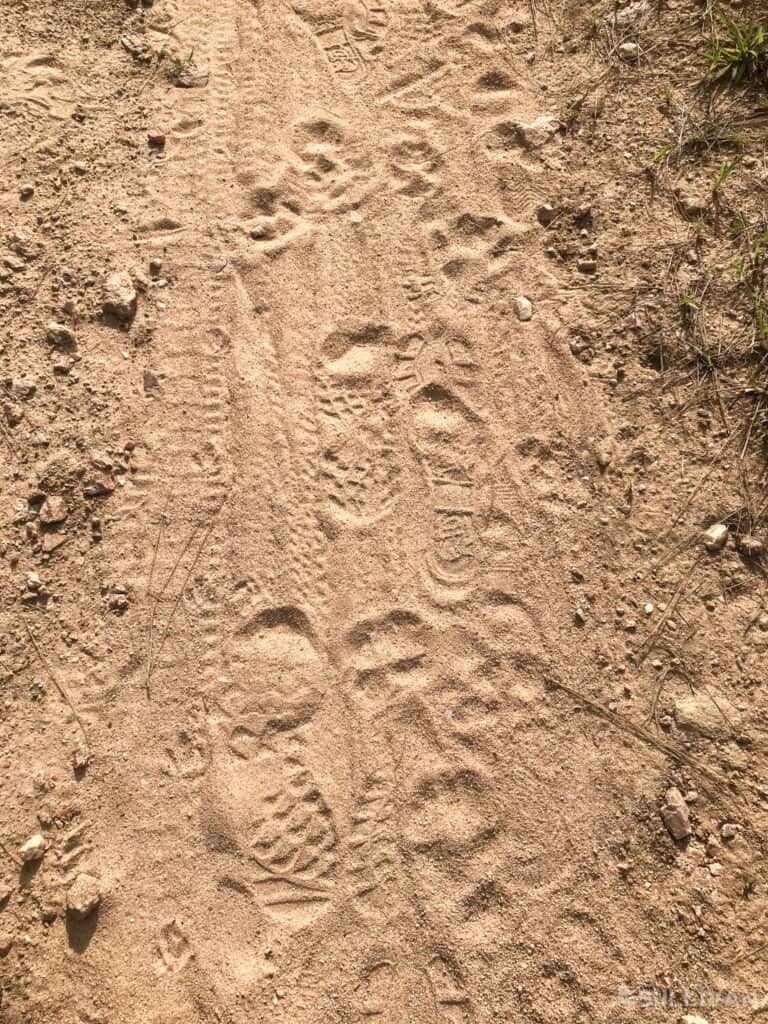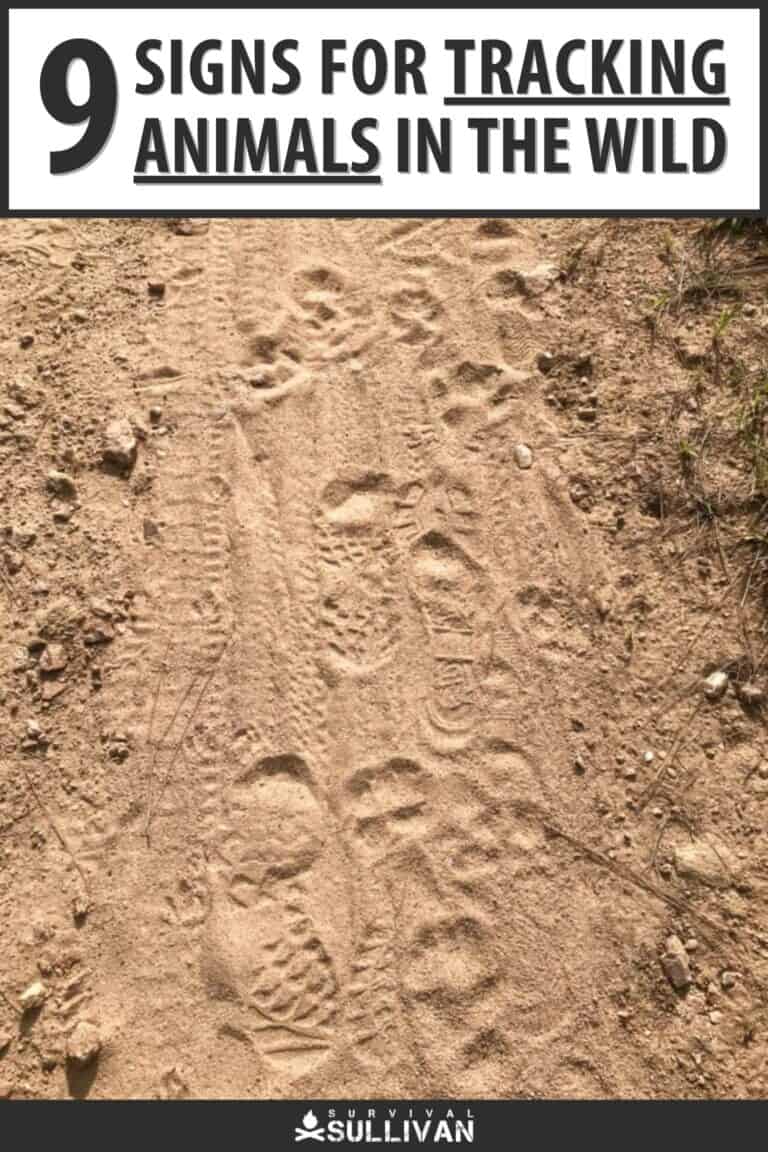When you are out in the wilderness, whether you’re hunting, camping, or flat out surviving, learning how to locate animals can be instrumental to your success.
You might be out looking for them in the first place if you’re hunting, or you might desperately need a source of food in a survival situation. Similarly, if you are out camping, avoiding certain dangerous animals is paramount for safety.

But the wilderness is a big place, and determining what is sharing the wilderness with you nearby is extremely difficult if you don’t know how to track.
Tracking animals isn’t some inherited magical ability, it’s a survival skill that anyone can learn and develop. Fundamental to that skill is learning to identify signs of animal presence.
I’ll get you started with nine signs that you should always be alert for when hunting down or being cautious of animals.
1. Prints and Tracks
Prints and tracks are the most straightforward identifiers when tracking animals in the wild. They are particularly visible in soft terrain such as mud, sand, or fresh snow where the imprint of an animal’s foot can be clearly seen.
This allows trackers to identify not only the presence of an animal but usually the species and subspecies as well; different animals have distinctively shaped footprints.
However, prints and tracks can be hard or even impossible to spot on hard-packed terrain like rock or dry, compacted soil.
Therefore, learning to identify various species from partial prints alone is a crucial skill for any advanced tracker. This requires a keen eye, attention to detail, and a deeper understanding of the animals you are tracking.
2. Trails and Runs
While prints and tracks can provide direct evidence of an animal’s presence and heading, trails and runs offer more subtle, general clues.
Trails are larger paths that are typically used by multiple species of animals, and might appear as trampled grass, well worn-down dirt paths, or areas where vegetation has been seriously disturbed or pressed back by repeated passage.
On the other hand, runs are smaller, subtler paths used by a few species or even just one.
These paths might be harder to spot and require careful observation, and tiny runs left by rodents and reptiles are usually only seen when you’re down your belly in kind!
Paying close attention to trails and runs can lead you directly to animals, though, making this a vital sign for trackers.
By noting the size, shape, and direction of these paths, you can gather valuable information about an animal (or animals, plural) size, behavior, and the direction it has taken before.
3. Nest and Bedding Areas
Each and every animal species has its own unique set of habits and preferences when it comes to choosing or creating a place to rest or nest.
For instance, some animals may prefer to nest in depressions in deep foliage or ground cover, while others may choose out-of-the-way places for better protection from predators.
Trees, burrows, caves and other terrain features can also serve as likely nesting sites depending on the species you’re tracking.
Also, many species exhibit seasonal changes in their nesting and bedding behavior. This could be due to breeding seasons or changes in food availability and weather conditions.
Brushing up on your knowledge about the specific species you’re tracking and other animals in the region will help you better interpret info when you spot nests or bedding areas.
4. Droppings
Although it is gross to the uninitiated, droppings can provide a wealth of information about the animal you’re tracking.
Different animals leave different types of droppings, each with a distinct shape, size, texture, and typical contents. These differences can help identify the species, as well as provide clues about the animal’s diet and health.
In addition, some animals use their droppings to mark territory or leave sign with others of their kind.
Finding fresh droppings can indicate that an animal has been in the area recently, while dry and desiccated turds means the creature left them a long time ago.
Keeping a close eye out for droppings, and understanding what they can tell you, is a high priority when tracking larger animals.
5. Odor
In the realm of animal tracking, you shouldn’t neglect your other senses in favor of sight alone. Your sense of smell can be an invaluable tool!
Animals emit or leave behind a variety of distinctive odors that can serve as important indicators of their presence.
The most obvious sources of these odors are feces and urine, with each species producing a unique variety of scents.
Aside from waste, some animals also emit a distinct musk, a strong-smelling substance often secreted by males for marking territory, scaring off competitors or attracting mates.
A fresh, clear odor lingering in the air can tell you a lot about the recent activities of animals in the area.
For example, if you come across a noticeable smell near a bedding location, it might suggest that you just missed your quarry!
Training your nose to identify and interpret these scents will certainly enhance your tracking skills and increase your chances of successfully locating the animal you’re after.
6. Fur
Another sometimes-obvious sign to look out for when tracking animals is bits of fur or dropped feathers.
Animals shed either as part of their natural life processes, such as molting or due to seasonal changes when they need more or less insulation from the elements.
Injury or incidental contact with the surrounding terrain can also result in patches of fur or feathers being left behind.
Particularly, dense bushes, trees, and thorny plants are likely places to find these signs as animals often pass through or rest in these areas and their fur gets snagged.
With enough knowledge of the unique colors, textures and details, finding fur or feathers can help positively identify the species you’re tracking, and sometimes give you clues about the direction of their travel.
Sometimes, the overall quality of the specimen or the presence of parasites can give you more clues about disease or diet, too.
7. Calls and Sounds
Sounds and calls animals make are a gift when tracking them! Different creatures make different sounds, each with their own reason.
These could range from mating calls to sounds of distress or warning calls of aggravation. Some animals make sounds to signal their presence to intruders, warning off potential threats or competitors.
The volume and nature of these sounds can vary greatly depending on the species in question and reason for the call.
Some, like the roar of a bear or the bellow of a moose, can be loud enough to be heard over vast distances. Meanwhile, others, like the almost-indiscernible nibbling of a mouse require keen listening skills to detect.
By keeping your ears perked and learning to recognize these various sounds, you might hear the animal you’re tracking before you even see it!
8. Food and Feeding Areas
Understanding an animal’s diet and recognizing signs of fresh feeding can provide yet more insights into its presence, direction and behavior.
Just as different animals leave unique prints, they also leave distinctive marks when they feed on various things.
For instance, deer are known to feed on a variety of vegetation. You might notice neatly clipped twigs and shrubs or grass pulled up and roughly cut, indicating a deer has been feeding in the area.
On the other hand, signs of a bear might include heavily torn-up earth, a smashed bee nest, or the mauled and scattered remains of other animal carcasses; bears are omnivorous, consuming both plants and meat.
Sometimes they are just clues, but other times these signs can provide precious intel!
9. Blood
Especially when hunting, blood is a highly significant sign. If you’re hunting and have managed to wound your prey, they are very likely to leave behind traces of blood as they move.
Keeping your eyes open for such traces is fundamental in tracking down your injured quarry.
However, keep in mind that animals don’t just bleed due to human attack. They often fight with each other, and sometimes fall prey to predators. Either instance can also result in bleeding.
Finding any blood traces can indicate recent animal activity, even if it’s not directly related to your quarry.
Reading contact clues like quantity, interval, splash, smear, and trail can tell you more about what kind of animal might have left it behind.
While it’s usually impossible to distinguish between the blood of different animals, combined with other contextual clues it is possible to make some informed guesses.
For instance, the location of the blood or its proximity to other signs like tracks, droppings, or feeding marks can give you a better understanding of what might have occurred.
So while blood alone may not reveal the exact species, it’s still a valid and often highly visible indicator when tracking.


Tom Marlowe practically grew up with a gun in his hand, and has held all kinds of jobs in the gun industry: range safety, sales, instruction and consulting, Tom has the experience to help civilian shooters figure out what will work best for them.
